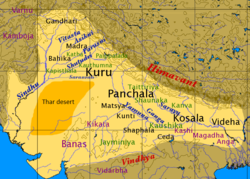Madra
Thank you for being part of the Bharatpedia family! 0% transparency: ₹0 raised out of ₹100,000 (0 supporter) |

Madra (IAST: Madra; [mɐdɽɐ]) is the name of an ancient region and its inhabitants, located in the north-west division of the ancient Indian sub-continent. The kingdom's boundaries are believed to have extended from Syria and portions of Mesopotamia (possibly as far as Western Iraq (Al Anbar) to the present day. Some support for this belief lies within the ancient epic, the Mahabharata that describes the armies of the Madra Kingdom led by King Shalya, marching from ancient Syria to what would be known today as Haryana.[1][2][3]
The Madra are numerously referenced in ancient Sanskrit and Pali literature and some scholarly work references them as being part of the Kshatriya group during the time of the Mahabharata (the Vedic Period).[4]
Recent scholarly work references the Madra kingdom existing for at least two thousand years and places its home between the Ravi and Chenab rivers of Punjab region.[5][6] The Kingdom of Madra was founded by Madra who was the son of Shibi in Treta Yuga.
See also[edit]
References[edit]
- ↑ Menon, Ramesh (2006). The Mahabharata, A modern rendering. iUniverse. ISBN 9780595401888.
- ↑ Ganguly, Kisari. "The Mahabharata". www.sacred-texts.com.
- ↑ Przyluski, Jean (1960). Ancient Peoples of the Punjab. University of Minnesota: K. L. Mukhopadhyaya. pp. vi, 7–8.
- ↑ Law, Dr. Bimla Charan (1924). Some Ksatriya Tribes of Ancient India. University of Calcutta. pp. 214–229.
- ↑ Hamadani, Agha Hussain (1986). The frontier policy of the Delhi Sultans. National Institute of Historical and Cultural Research. p. 112.
- ↑ Bajpai, Shiva Chandra (S.C.) (1987). Lahaul-Spiti: A Forbidden Kingdom in the Himalayas (Fourth ed.). Indus Publishing Company. p. 11. ISBN 9788173871139.
